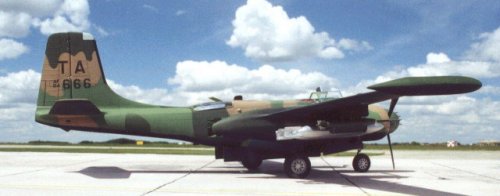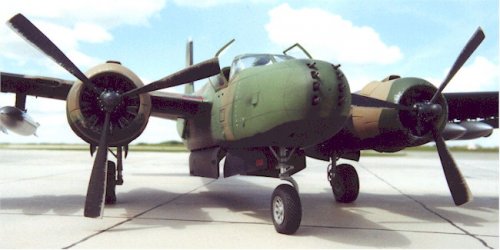I've read of these a/c off & their mods/upgrades proposed. More powerful engines, raised cockit & 'blown' canopy, jettisonable wingtip fuel tanks. ISTR reading that some of the mods were later used in the A-26K. I've never seen any drawings of the proposals, only the descriptions. I've been considering building a model of one, of my interpretation of the descriptions. As for A-26K mods, I suspect 4 blade props instead of the fat 3 blade ones on the A-26K & I can't see the pointed, streamlined tip tanks either, maybe the basic teardrop shaped tanks of WWII vintage, only mounted at the tips. As for the raised cockpit & blown canopy, I can imagine the same treatment as done to the later P2V Neptunes. However, as many unusual a/c types that show up around here, I thought someone might have further info, like drawings or something. Anything, anyone?
You are using an out of date browser. It may not display this or other websites correctly.
You should upgrade or use an alternative browser.
You should upgrade or use an alternative browser.
Douglas A-26G/H planned post WWII Invader
- Thread starter frank
- Start date
- Joined
- 26 May 2006
- Messages
- 34,911
- Reaction score
- 15,788
- Joined
- 21 May 2006
- Messages
- 3,002
- Reaction score
- 2,281
Yes it would be interesting to see drawings of this updated ‘Invader’ proposal.
I know that the piston engine is more fuel efficient at low altitude – the area where most COIN aircraft spend their time!
But a turboprop-powered version would also look great.
And what about downward-firing 12.7mm (.50 cal) or 20mm cannons - the opposite to the German ‘Schrage Musik’ (‘Jazz Music’) installation, to engage ground targets when flying over them???
I know that the piston engine is more fuel efficient at low altitude – the area where most COIN aircraft spend their time!
But a turboprop-powered version would also look great.
And what about downward-firing 12.7mm (.50 cal) or 20mm cannons - the opposite to the German ‘Schrage Musik’ (‘Jazz Music’) installation, to engage ground targets when flying over them???
OnMark proposed a turboprop version of their corporate design, using Allison 501s. I've seen a pic of a model & an artist concept. The fuselage was drastically modified, moreso than their other corporate mods. I've often wondered if the war in SEA had continued, & OnMark produced their TP version, if the USAF would have followed similarly. I built a model of a "Turbo Nimrod" a year or so back.
Pioneer said:Yes it would be interesting to see drawings of this updated ‘Invader’ proposal.
I know that the piston engine is more fuel efficient at low altitude – the area where most COIN aircraft spend their time!
But a turboprop-powered version would also look great.
And what about downward-firing 12.7mm (.50 cal) or 20mm cannons - the opposite to the German ‘Schrage Musik’ (‘Jazz Music’) installation, to engage ground targets when flying over them???
thewanderingmind
Werfless
- Joined
- 2 August 2006
- Messages
- 25
- Reaction score
- 7
Pioneer said:...And what about downward-firing 12.7mm (.50 cal) or 20mm cannons - the opposite to the German ‘Schrage Musik’ (‘Jazz Music’) installation, to engage ground targets when flying over them???
Unneeded! I used to watch A-26's on the night range, and when they'd cut loose with those eight .50 calibers in the nose, the world ended in the target area! In fact, for firepower demo's, they'd occasionally hang a few .50 pods under the wings of one aircraft, and the end effect was frightfull! Downward-firing machine guns were not the problem. What the A-26 really needed - but couldn't really get because of weight and manning problems - was a couple of rearward-firing machine guns. After your rounds impacted on a strafing pass, the enemy would pop back up and unload in your belly and tail areas as you passed over...
If memory serves, there was unofficial experimentation with a couple of our OV-10A Broncos over the Eglin ranges. The tail cone hatch was removed, and a gunner with an M-60 cargo-strapped himself into that little cargo area and tried spraying the target area during pull-ups after a marking run. Since it was eventually apparently decided this was basically a suicide mission for the gunner (The pilot and backseater had ejection seats), and the added weight was too big of a fuel penalty, the idea was dropped. Then, the powers-that-be even ordered the sponson-mounted machine guns removed from the Broncos, since they were supposed to mark targets - not get into firefights with the enemy on the ground! This may have cost us a few people on the ground who needed immediate air cover, but it probably saved the lives of quite a few forward air controllers who would have gotten "down and dirty" trying to keep the enemy back until more airpower arrived.
Vahe Demirjian
I really should change my personal text
- Joined
- 28 February 2013
- Messages
- 815
- Reaction score
- 570
According to Joe Baugher, the A-26G and A-26H both differed in the nose structure, with the A-26G having a solid nose section and the A-26H having a glazed nose section. Does anyone have drawings of the A-26G and A-26H?
ZacYates
LHX SuperTeam fanboy
- Joined
- 26 December 2012
- Messages
- 156
- Reaction score
- 136
I recently discovered the G and H models through Wikipedia and, like frank eay back when, I’d love to see any imagery related to the proposals for model building purposes. I hope someone has unearthed something in the past 18yr?
- Joined
- 25 July 2007
- Messages
- 4,299
- Reaction score
- 4,197
... I’d love to see any imagery related to the proposals for model building purposes...
Zac: To imagine the Douglas A-26G, just take a look at the later On Mark B-26K Counter Invader conversions. In effect, the A-26G was to have been the new-build equivalent to the B-26K - complete with tip tanks and that raised cockpit roof.
The other 'A-26Z' would be identical - other than the A-26H having a 'glass nose'.
BTW, does anyone know which model of "more powerful version of the Pratt & Whitney R-2800 radial engine" was to be used? Since the 'A-26Z' concepts derived from the XA-26D and XA-26E, my guess would be the latters' 2,100 hp R-2800-83. But does anyone know for sure?
Christopher Wang
ACCESS: Secret
- Joined
- 3 June 2021
- Messages
- 275
- Reaction score
- 586
Were there ever plans to replace the Invader's eight nose-mounted and six wing-mounted .50-cal Brownings with 20mm autocannons?
ZacYates
LHX SuperTeam fanboy
- Joined
- 26 December 2012
- Messages
- 156
- Reaction score
- 136
Is it known whether it would have had the larger vertical stabiliser as seen on the K?In effect, the A-26G was to have been the new-build equivalent to the B-26K
- Joined
- 11 March 2012
- Messages
- 3,249
- Reaction score
- 3,179
About the time that OnMark was mocking-up the turboprop conversion, they discovered corrosion, which cancelled it.OnMark proposed a turboprop version of their corporate design, using Allison 501s. I've seen a pic of a model & an artist concept. The fuselage was drastically modified, moreso than their other corporate mods. I've often wondered if the war in SEA had continued, & OnMark produced their TP version, if the USAF would have followed similarly. I built a model of a "Turbo Nimrod" a year or so back.
Scott Kenny
ACCESS: USAP
- Joined
- 15 May 2023
- Messages
- 11,649
- Reaction score
- 14,358
Probably not, the USAF didn't have any good 20mms to work with (just M39), they'd probably end up dropping that to maybe 4x nose and 4x wing guns.Were there ever plans to replace the Invader's eight nose-mounted and six wing-mounted .50-cal Brownings with 20mm autocannons?
Firefinder
ACCESS: Top Secret
- Joined
- 5 October 2019
- Messages
- 1,049
- Reaction score
- 1,904
There was plans for a Four gun 20mm nose, a triple 37mm, and even a plan for a 37mm plus 76mm.
As is 8 50s will shredd much til the mid 70s
As is 8 50s will shredd much til the mid 70s
Similar threads
-
-
-
Flight Refuelling Limited's Projects post 1945
- Started by Hood
- Replies: 1
-
-
Lockheed of the late '60s 1 - Model CL-1054
- Started by Skybolt
- Replies: 3


